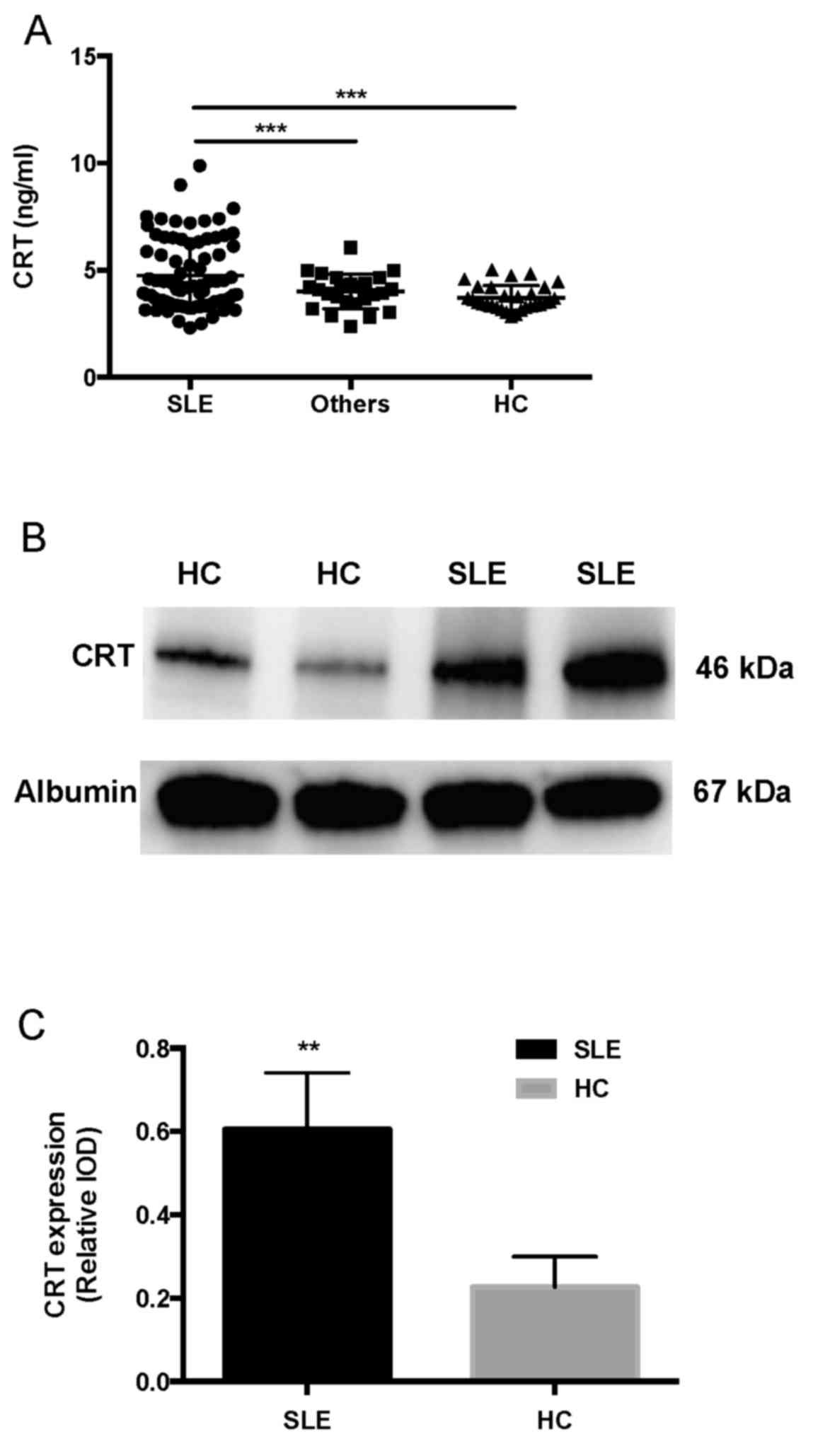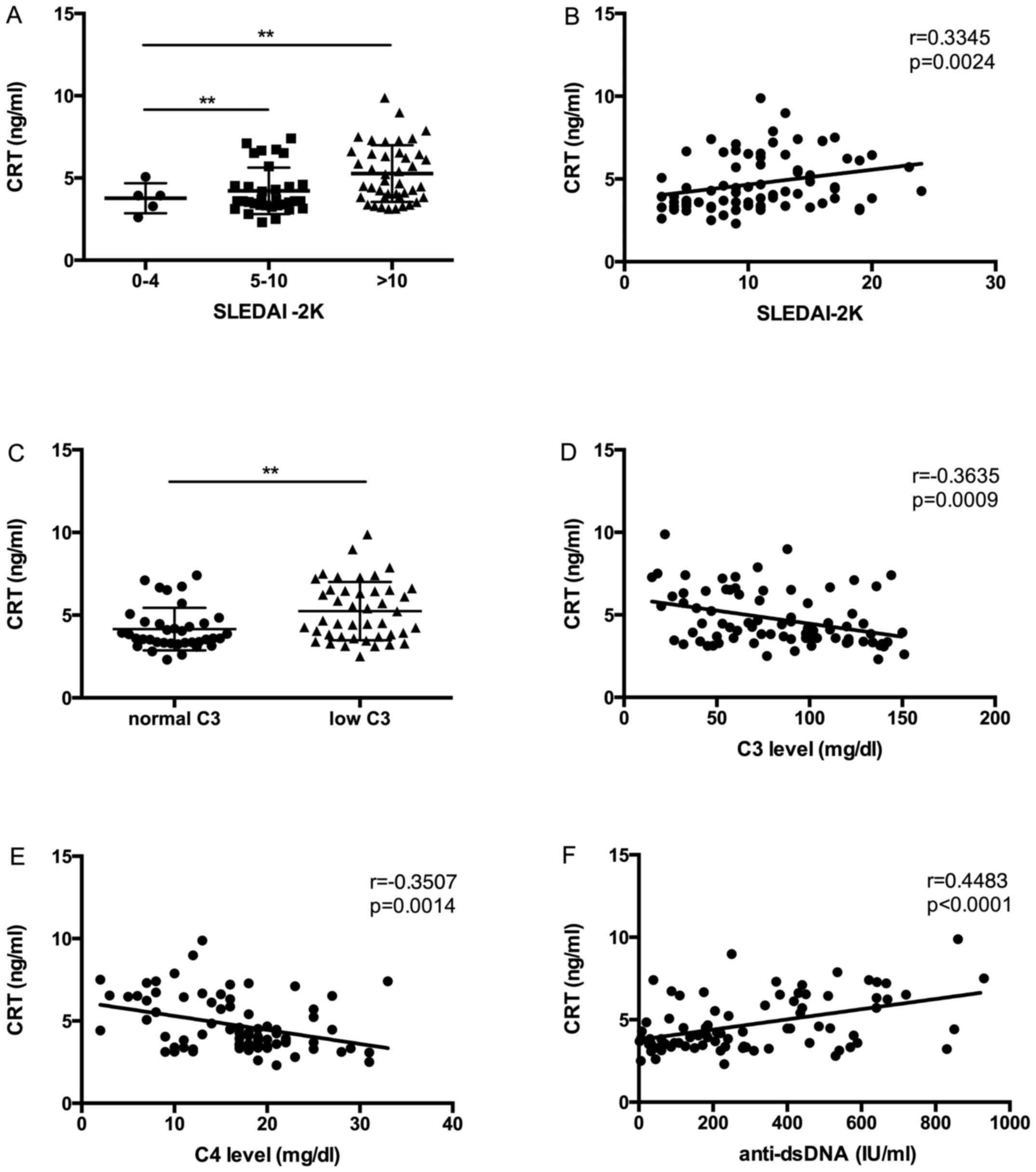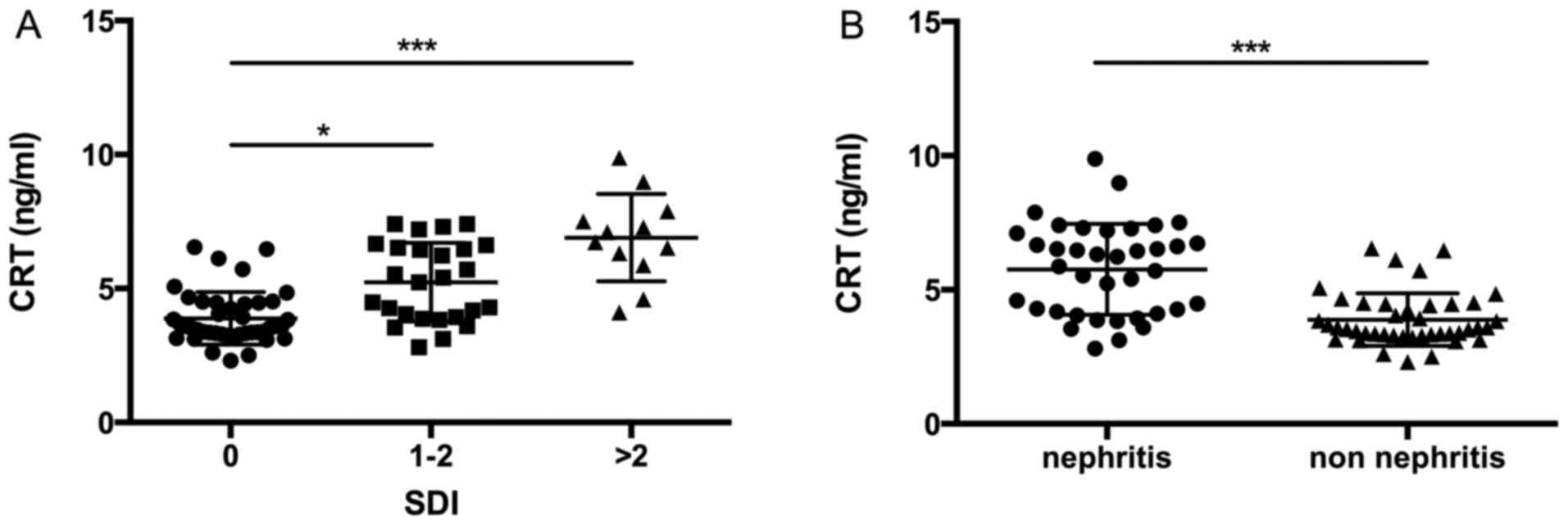|
1
|
Liang P, Tang Y, Fu S, Lv J, Liu B, Feng
M, Li J, Lai D, Wan X and Xu A: Basophil count, a marker for
disease activity in systemic lupus erythematosus. Clin Rheumatol.
34:891–896. 2015. View Article : Google Scholar : PubMed/NCBI
|
|
2
|
Dipti TR, Azam MS, Sattar MH and Rahman
SA: Detection of anti-nuclear antibody by immunofluorescence assay
and enzyme immunoassay in childhood systemic lupus erythematosus:
Experience from Bangladesh. Int J Rheum Dis. 15:121–125. 2012.
View Article : Google Scholar : PubMed/NCBI
|
|
3
|
Das UN: Current and emerging strategies
for the treatment and management of systemic lupus erythematosus
based on molecular signatures of acute and chronic inflammation. J
Inflamm Res. 3:143–170. 2010. View Article : Google Scholar : PubMed/NCBI
|
|
4
|
Devaraju P, Witte T, Schmidt RE, Gulati R
and Negi VS: Immunoglobulin-like transcripts 6 (ILT6) polymorphism
influences the anti-Ro60/52 autoantibody status in South Indian SLE
patients. Lupus. 23:1149–1155. 2014. View Article : Google Scholar : PubMed/NCBI
|
|
5
|
Eggleton P and Llewellyn DH:
Pathophysiological roles of calreticulin in autoimmune disease.
Scand J Immunol. 49:466–473. 1999. View Article : Google Scholar : PubMed/NCBI
|
|
6
|
Eggleton P, Ward FJ, Johnson S, Khamashta
MA, Hughes GR, Hajela VA, Michalak M, Corbett EF, Staines NA and
Reid KB: Fine specificity of autoantibodies to calreticulin:
Epitope mapping and characterization. Clin Exp Immunol.
120:384–391. 2000. View Article : Google Scholar : PubMed/NCBI
|
|
7
|
Yan Q, Murphy-Ullrich JE and Song Y:
Structural insight into the role of thrombospondin-1 binding to
calreticulin in calreticulin-induced focal adhesion disassembly.
Biochemistry. 49:3685–3694. 2010. View Article : Google Scholar : PubMed/NCBI
|
|
8
|
Goëb V, Thomas-L'Otellier M, Daveau R,
Charlionet R, Fardellone P, Le Loët X, Tron F, Gilbert D and
Vittecoq O: Candidate autoantigens identified by mass spectrometry
in early rheumatoid arthritis are chaperones and citrullinated
glycolytic enzymes. Arthritis Res Ther. 11:R382009. View Article : Google Scholar : PubMed/NCBI
|
|
9
|
de Almeida DE, Ling S and Holoshitz J: New
insights into the functional role of the rheumatoid arthritis
shared epitope. FEBS Lett. 585:3619–3626. 2011. View Article : Google Scholar : PubMed/NCBI
|
|
10
|
Michalak M, Groenendyk J, Szabo E, Gold LI
and Opas M: Calreticulin, a multi-process calcium-buffering
chaperone of the endoplasmic reticulum. Biochem J. 417:651–666.
2009. View Article : Google Scholar : PubMed/NCBI
|
|
11
|
van den Berg RH, Siegert CE, Faber-Krol
MC, Huizinga TW, van Es LA and Daha MR: Anti-C1q
receptor/calreticulin autoantibodies in patients with systemic
lupus erythematosus (SLE). Clin Exp Immunol. 111:359–364. 1998.
View Article : Google Scholar : PubMed/NCBI
|
|
12
|
Boehm J, Orth T, Van Nguyen P and Söling
HD: Systemic lupus erythematosus is associated with increased
auto-antibody titers against calreticulin and grp94, but
calreticulin is not the Ro/SS-A antigen. Eur J Clin Invest.
24:248–257. 1994. View Article : Google Scholar : PubMed/NCBI
|
|
13
|
Hong C, Qiu X, Li Y, Huang Q, Zhong Z,
Zhang Y, Liu X, Sun L, Lv P and Gao XM: Functional analysis of
recombinant calreticulin fragment 39–272: Implications for
immunobiological activities of calreticulin in health and disease.
J Immunol. 185:4561–4569. 2010. View Article : Google Scholar : PubMed/NCBI
|
|
14
|
Yuan J, Li LI, Wang Z, Song W and Zhang Z:
Dyslipidemia in patients with systemic lupus erythematosus:
Association with disease activity and B-type natriuretic peptide
levels. Biomed Rep. 4:68–72. 2016.PubMed/NCBI
|
|
15
|
Urowitz MB, Isenberg DA and Wallace DJ:
Safety and efficacy of hCDR1 (Edratide) in patients with active
systemic lupus erythematosus: Results of phase II study. Lupus Sci
Med. 2:e0001042015. View Article : Google Scholar : PubMed/NCBI
|
|
16
|
Kvarnstrom M, Dzikaite-Ottosson V,
Ottosson L, Gustafsson JT, Gunnarsson I, Svenungsson E and
Wahren-Herlenius M: Autoantibodies to the functionally active
RING-domain of Ro52/SSA are associated with disease activity in
patients with lupus. Lupus. 22:477–485. 2013. View Article : Google Scholar : PubMed/NCBI
|
|
17
|
Romero-Diaz J, Isenberg D and
Ramsey-Goldman R: Measures of adult systemic lupus erythematosus:
Updated version of British Isles Lupus Assessment Group (BILAG
2004), European Consensus Lupus Activity Measurements (ECLAM),
Systemic Lupus Activity Measure, Revised (SLAM-R), Systemic Lupus
Activity Questionnaire for Population Studies (SLAQ), Systemic
Lupus Erythematosus Disease Activity Index 2000 (SLEDAI-2K), and
Systemic Lupus International Collaborating Clinics/American College
of Rheumatology Damage Index (SDI). Arthritis Care Res (Hoboken).
63 Suppl 1:S37–S46. 2011. View Article : Google Scholar : PubMed/NCBI
|
|
18
|
Ziegelasch M, van Delft MA, Wallin P,
Skogh T, Magro-Checa C, Steup-Beekman GM, Trouw LA, Kastbom A and
Sjöwall C: Antibodies against carbamylated proteins and cyclic
citrullinated peptides in systemic lupus erythematosus: Results
from two well-defined European cohorts. Arthritis Res Ther.
18:2892016. View Article : Google Scholar : PubMed/NCBI
|
|
19
|
Imrich R, Alevizos I, Bebris L, Goldstein
DS, Holmes CS, Illei GG and Nikolov NP: Predominant glandular
cholinergic dysautonomia in patients with primary Sjögren's
syndrome. Arthritis Rheumatol. 67:1345–1352. 2015. View Article : Google Scholar : PubMed/NCBI
|
|
20
|
Wang C, Liao Q, Hu Y and Zhong D: T
lymphocyte subset imbalances in patients contribute to ankylosing
spondylitis. Exp Ther Med. 9:250–256. 2015.PubMed/NCBI
|
|
21
|
Johnson SR, Fransen J, Khanna D, Baron M,
van den Hoogen F, Medsger TA Jr..Peschken CA, Carreira PE,
Riemekasten G, Tyndall A, et al: Validation of potential
classification criteria for systemic sclerosis. Arthritis Care Res
(Hoboken). 64:358–367. 2012. View Article : Google Scholar : PubMed/NCBI
|
|
22
|
Zhu XH, Chen Q, Ke JW, Liu JM, Li L, Li J,
He MJ and Hu CL: Clinical analysis of immune function changes in
children with bronchial pneumonia. Zhongguo Dang Dai Er Ke Za Zhi.
15:175–178. 2013.(In Chinese). PubMed/NCBI
|
|
23
|
Munroe ME, Vista ES, Guthridge JM,
Thompson LF, Merrill JT and James JA: Pro-inflammatory adaptive
cytokines and shed tumor necrosis factor receptors are elevated
preceding systemic lupus erythematosus disease flare. Arthritis
Rheumatol. 66:1888–1899. 2014. View Article : Google Scholar : PubMed/NCBI
|
|
24
|
Papp K, Végh P, Hóbor R, Szittner Z, Vokó
Z, Podani J, Czirják L and Prechl J: Immune complex signatures of
patients with active and inactive SLE revealed by multiplex protein
binding analysis on antigen microarrays. PLoS One. 7:e448242012.
View Article : Google Scholar : PubMed/NCBI
|
|
25
|
Brendan M and Boackle SA: Linking
complement and anti-dsDNA antibodies in the pathogenesis of
systemic lupus erythematosus. Immunol Res. 55:10–21. 2013.
View Article : Google Scholar : PubMed/NCBI
|
|
26
|
Magro-Checa C, Zirkzee EJ, Huizinga TW and
Steup-Beekman GM: Management of neuropsychiatric systemic lupus
erythematosus: Current approaches and future perspectives. Drugs.
76:459–483. 2016. View Article : Google Scholar : PubMed/NCBI
|
|
27
|
Wu Y, Zhang F, Ma J, Zhang X, Wu L, Qu B,
Xia S, Chen S, Tang Y and Shen N: Association of large intergenic
noncoding RNA expression with disease activity and organ damage in
systemic lupus erythematosus. Arthritis Res Ther. 17:1312015.
View Article : Google Scholar : PubMed/NCBI
|
|
28
|
Gelebart P, Opas M and Michalak M:
Calreticulin, a Ca2+-binding chaperone of the endoplasmic
reticulum. Int J Biochem Cell Biol. 37:260–266. 2005. View Article : Google Scholar : PubMed/NCBI
|
|
29
|
He MC, Wang J, Wu J, Gong FY, Hong C, Xia
Y, Zhang LJ, Bao WR and Gao XM: Immunological activity difference
between native calreticulin monomers and oligomers. PLoS One.
9:e1055022014. View Article : Google Scholar : PubMed/NCBI
|
|
30
|
Ni M, Wei W, Wang Y, Zhang N, Ding H, Shen
C and Zheng F: Serum levels of calreticulin in correlation with
disease activity in patients with rheumatoid arthritis. J Clin
Immunol. 33:947–953. 2013. View Article : Google Scholar : PubMed/NCBI
|
|
31
|
Compagno M, Gullstrand B, Jacobsen S,
Eilertsen GØ, Nilsson JÅ, Lood C, Jönsen A, Truedsson L, Sturfelt G
and Bengtsson AA: The assessment of serum-mediated phagocytosis of
necrotic material by polymorphonuclear leukocytes to diagnose and
predict the clinical features of systemic lupus erythematosus: An
observational longitudinal study. Arthritis Res Ther. 18:442016.
View Article : Google Scholar : PubMed/NCBI
|
|
32
|
Borba VZ, Vieira JG, Kasamatsu T,
Radominski SC, Sato EI and Lazaretti-Castro M: Vitamin D deficiency
in patients with active systemic lupus erythematosus. Osteoporos
Int. 20:427–433. 2009. View Article : Google Scholar : PubMed/NCBI
|
|
33
|
McCarthy EM, Smith S, Lee RZ, Cunnane G,
Doran MF, Donnelly S, Howard D, O'Connell P, Kearns G, Ní Gabhann J
and Jefferies CA: The association of cytokines with disease
activity and damage scores in systemic lupus erythematosus
patients. Rheumatology (Oxford). 53:1586–1594. 2014. View Article : Google Scholar : PubMed/NCBI
|
|
34
|
Umare V, Pradhan V, Nadkar M, Rajadhyaksha
A, Patwardhan M, Ghosh KK and Nadkarni AH: Effect of
proinflammatory cytokines (IL-6, TNF-α, and IL-1β) on clinical
manifestations in Indian SLE patients. Mediators Inflamm.
2014:3852972014. View Article : Google Scholar : PubMed/NCBI
|
|
35
|
Duo CC, Gong FY, He XY, Li YM, Wang J,
Zhang JP and Gao XM: Soluble calreticulin induces tumor necrosis
factor-a (TNF-α) and interleukin (IL)-6 production by macrophages
through mitogen-activated protein kinase (MAPK) and NFκB signaling
pathways. Int J Mol Sci. 15:2916–2928. 2014. View Article : Google Scholar : PubMed/NCBI
|
|
36
|
Routsias JG, Tzioufas AG,
Sakarellos-Daitsiotis M, Sakarellos C and Moutsopoulos HM:
Calreticulin synthetic peptide analogues: Anti-peptide antibodies
in autoimmune rheumatic diseases. Clin Exp Immunol. 91:437–441.
1993. View Article : Google Scholar : PubMed/NCBI
|
|
37
|
Kinoshita G, Keech CL, Sontheimer RD,
Purcell A, McCluskey J and Gordon TP: Spreading of the immune
response from 52 kDaRo and 60 kDaRo to calreticulin in experimental
autoimmunity. Lupus. 7:7–11. 1998. View Article : Google Scholar : PubMed/NCBI
|
|
38
|
Menéndez A, Gómez J, Caminal-Montero L,
Díaz-López JB, Cabezas-Rodríguez I and Mozo L: Common and specific
associations of anti-SSA/Ro60 and anti-Ro52/TRIM21 antibodies in
systemic lupus erythematosus. ScientificWorldJournal.
2013:8327892013. View Article : Google Scholar : PubMed/NCBI
|
|
39
|
Wang WA, Groenendyk J and Michalak M:
Calreticulin signaling in health and disease. Int J Biochem Cell
Biol. 44:842–846. 2012. View Article : Google Scholar : PubMed/NCBI
|
|
40
|
Sela-Brown A, Russell J, Koszewski NJ,
Michalak M, Naveh-Many T and Silver J: Calreticulin inhibits
vitamin D's action on the PTH gene in vitro and may prevent vitamin
D's effect in vivo in hypocalcemic rats. Mol Endocrinol.
12:1193–1200. 1998. View Article : Google Scholar : PubMed/NCBI
|
|
41
|
Wheeler DG, Horsford J, Michalak M, White
JH and Hendy GN: Calreticulin inhibits vitamin D3 signal
transduction. Nucleic Acids Res. 23:3268–3274. 1995. View Article : Google Scholar : PubMed/NCBI
|
|
42
|
Amital H, Szekanecz Z, Szücs G, Dankó K,
Nagy E, Csépány T, Kiss E, Rovensky J, Tuchynova A, Kozakova D, et
al: Serum concentrations of 25-OH vitamin D in patients with
systemic lupus erythematosus (SLE) are inversely related to disease
activity: Is it time to routinely supplement patients with SLE with
vitamin D? Ann Rheum Dis. 69:1155–1157. 2010. View Article : Google Scholar : PubMed/NCBI
|
|
43
|
Mandal M, Tripathy R, Panda AK, Pattanaik
SS, Dakua S, Pradhan AK, Chakraborty S, Ravindran B and Das BK:
Vitamin D levels in Indian systemic lupus erythematosus patients:
Association with disease activity index and interferon alpha.
Arthritis Res Ther. 16:R492014. View
Article : Google Scholar : PubMed/NCBI
|
|
44
|
Schoindre Y, Jallouli M, Tanguy ML,
Ghillani P, Galicier L, Aumaître O, Francès C, Le Guern V, Lioté F,
Smail A, et al: Lower vitamin D levels are associated with higher
systemic lupus erythematosus activity, but not predictive of
disease flare-up. Lupus Sci Med. 1:e0000272014. View Article : Google Scholar : PubMed/NCBI
|













